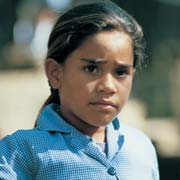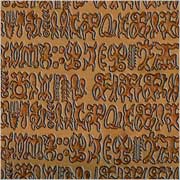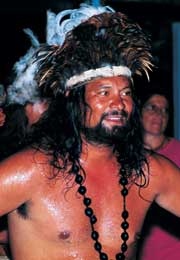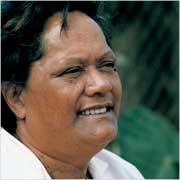The "Vananga" Rapa Nui is a language with Polynesian origins, it is a branch of the large Austronesic family, which also includes the Micronesian and many Melanesian languages. Austronesic family is a set of languages that spread from Asiatic southeast. Spoken today only by Rapa Nui people on Easter Island. It is the most accurate way to express their life and culture. It is widely spoken among the adult population.

Rapa Nui, like all languages, has incorporated words with different origins, and assimilated them into their own system of pronunciation and grammar.
The majority of Rapa Nui vocabulary is inherited directly from Proto Eastern Polynesian. There some changes in semantics and some uniquely Rapa Nui words but the majority of the vocabulary has cognates elsewhere in Polynesia.

Many words still used in Easter Island are of Tahitian origins, for example: "iorana" (hello, goodbye). The island's conversion to Catholicism during the second half of the XIX century was carried out with liturgical texts written in Tahitian.
Nowadays, Rapa Nui language has major transformations due to contact with foreigners words have been borrowed from Spanish, French, English and Tahitian.
The current language used by the islanders, known as "modern Rapa Nui" is different from that spoken before contact with the Europeans.
In the last years the school has been making effort to include cultural education in the curriculum, which includes teaching children their native language.

"Rongorongo" the name for the hieroglyphic script of Easter Island, engraved on oblong wooden tablets. It is assumed that Rongorongo, the undeciphered script of Easter Island, represents the old Rapa Nui language.
It has remained a mystery since its discovery. For over a hundred years, controversy has raged over the meaning and source of these enigmatic characters.
Most of Rapanui's Rongorongo inscriptions consist of parallel lines of signs or glyphs that represent human figures, birds, fishes, plants, geometrics, and other things. These fingernail size glyphs were traditionally incised on large battle staffs, driftwood tablets, small wooden "Birdmen" and other statuettes, pectorals, ceremonial paddles, and even human skulls. Rongorongo geoglyphs also figured among the inventory of special tattoos for the Rongorongo experts. On the staffs and tablets, every other line of Rongorongo appears upside down; this orientation forces the reader to rotate the artefact 180 degrees at the end of each line of glyphs, evidently to enable continuous reading and to avoid confusing the parallel lines. Rongorongo offers a fanciful parade of hieroglyphics, and for over 130 years many eminent scholars from many nations have burned the midnight oil in attempting to discover what this hieroglyphic parade celebrates.
Rapanui's Rongorongo script comprises one of the world's most fascinating writing systems. This is principally because Rongorongo is Oceania's only indigenous script that predates the twentieth century and because it represents one of the world's most eloquent graphic expressions, Rongorongo has also been, until very recently , one of the world's very few undeciphered writing systems.
There are only 21 known tablets in existence scattered in museums and private collections.

In 1864, the French lay missionary Eugene Eyraud, reported in a letter to his superior that he had seen on Easter Island or Rapa Nui in all the houses hundreds of tablets and staffs incised with thousands of hieroglyphic figures. He died in 1868.
In 1868 the Rongorongo inscriptions were rediscovered. Their second European discoverer was Tahiti's now legendary Catholic bishop Tepano Jaussen.
Suspecting that the Rapa Nui inscriptions might reveal the ancient origins of his Polynesian converts, Bishop Jaussen soon amassed the largest single collection of choice Rongorongo artefacts.
The bishop, elated at the discovery, writes to Father Hippolyte Roussel on Easter Island, exhorting him to gather all the tablets he can and to seek out natives able to translate them. But only a handful remain of the hundreds of tablets mentioned by Brother Eugene Eyraud only a few years earlier in a report to the Father Superior. Some say they were burnt to please the missionaries who saw in them evil relics of pagan times. Some say they were hidden to save them from destruction. Jaussen was not able to decipher the tablets.
In the 1930s the world was stunned by the claim of a Hungarian scientist Wilhelm Von Hevesy living in Paris that Easter Island's Rongorongo had derived from the Indus Valley script of approximately 2000 BC. Unfortunately, he had distorted some of the Rongorongo signs in the illustrations that accompanied his work. The majority of the genuine similarities correspond to simple images.
The French ethnologist Alfred Metraux, whose book "The Ethnology of Easter Island", published in 1941, continues to be one of the major and most complete studies on Rapa Nui culture.
In 1958, a German cryptologist, Thomas Barthel has invented a numerical code to reference most of the signs and their combinations. He has identified two and a half lines of one tablet which, contain a lunar calendar. He has included in his book "Grundlagen zur Entzifferung der Osterinselschrift" (Bases for the Decipherment of the Easter Island Script) faithful line reproductions of the hieroglyphic text of all the tablets, much easier to use and study than photographs. He never achieved what he had set out to do in the first place, decipher the writing. Despite, his work is considered essential.

In 1995 the Journal of the Polynesian Society published an article by Dr Fischer, where he claimed to have identified the nature of the tablets. They are chants, he says, of the form "So and so copulated with So and so begetting Such and such". Fischer has observed that there is a very strong tendency for every third sign on the tablet known as the Santiago Staff to comprise an appendage which he calls a "phallic suffix".

Recently, two linguists, Konstantin Pozdniakov from France and Martha Macri from the United States, published some articles suggesting that the Rongorongo script might be more phonetically complete than what has been thought to date. The quantity of signs is compatible with the idea that the script is mainly syllabic.
Useful phrases for tourists in Rapa Nui, Spanish, English and French:
| Rapa Nui | Spanish | English | French |
|---|---|---|---|
| Iorana | Hola / adiós | Hello / goodbye | Bonjour / adieu |
| Iorana korua | Hola / adiós (a ustedes) | Hello / goodbye (plural) | Bonjour / adieu (à vous) |
| ¿pe hè koe? | ¿Cómo estás? | How are you? | Comment vas-tu? |
| Riva riva | Estoy bien o muy bien | I am fine or very well | Je vais bien ou très bien |
| Rake rake | Estoy mal | I am not well | Ça va mal |
| Ena` à | Estoy más o menos | I’m ok | Je vais plus ou moins |
| ¿ko ai tu`u iŋoa? | ¿Cómo te llamas? | What is your name? |
Comment t’ appelles-tu? |
|
¿e hìa mata hiti o’ ou’ |
¿Cuántos años tienes? | How old are you? | Quel age as-tu? |
| Po nui | Buenas noches | Godd night | Bonsoir |
| ¿hora aha nei? | ¿Qué hora es? | What time is it? | Quelle heure est-il? |
| ¿i hè? | ¿Dónde? | Where? | Où? |
| ¿i hè e noho ena? | ¿Dónde vives? | Where do you live? | Où habitez –vous? |
|
¿e hìa tara? ¿e hìa moni? |
¿Cuánto cuesta? | How much does it cost? | Cambien ça coute? |
|
¿haŋa rò koe ha’ere? |
¿Quieres caminar? |
Would you like to go for a walk? |
Veux-tu faire une promenade? |
|
¿haŋa rò korua mo ha’uru? |
¿Quieren ustedes dormir? | Would you (pl.) like to sleep? |
Voulez-vous aller vous coucher? |
|
¿haŋa rò a ìa mo hopu? |
¿Quiere él / ella bañarse? | Would he / she like to take a bath / swim? | Veut-il / elle se baigner? |
| Maururu – mau uru uru | Gracias | Thank you | Merci |
| E è | Si | Yes | Oui |
| Ina | No | No | Non |
| Manuìa | ¡Salud! | Cheers! | A votre santè! |
| ¡Ka mou! | ¡Cállate! | Silence! | Tais-toi! |